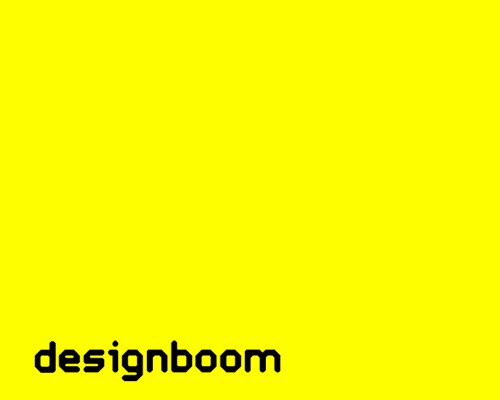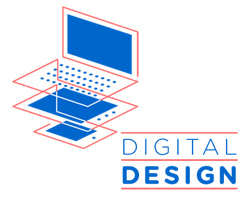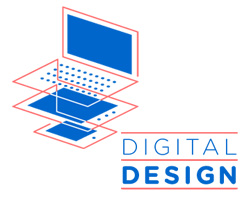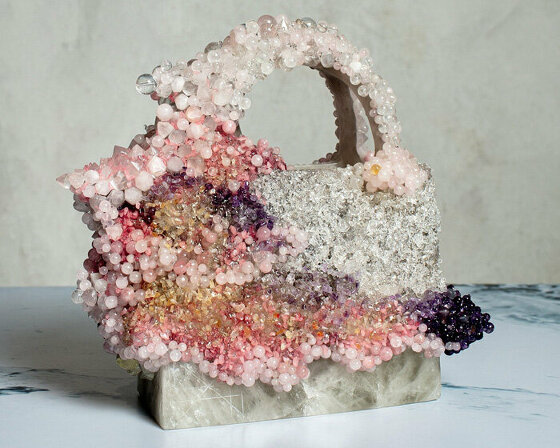— the following is an example of a lesson from the upcoming shopping course: money
money, something so thoroughly ingrained into practically every culture on the planet, is purely the invention of the human mind and we now depend on it for our survival as if it was food or shelter.
 lydian electrum trite (4.71g, 13x10x4 mm). this coin type, made of a gold and silver alloy, was in all likelihood the world’s first, minted by king alyattes in sardis, lydia, asia minor (present-day turkey), c. 610-600 BC. It can be attributed, among other ways, as weidauer 59-75
lydian electrum trite (4.71g, 13x10x4 mm). this coin type, made of a gold and silver alloy, was in all likelihood the world’s first, minted by king alyattes in sardis, lydia, asia minor (present-day turkey), c. 610-600 BC. It can be attributed, among other ways, as weidauer 59-75
trading on a primitive level we need food, water, clothing and shelter to survive. this is inescapable and so it is imperative that these things are produced. we have learned that by specializing in the activities we are good at, then we will be better off, because through trading we can get better goods with our better produce. thus, communities may become specialized in, say, axe head manufacture, grain or clothing production and it is from this that merchants were born and communities became mutually dependent on each other for survival.
it seems human nature to require something in return for something. the spirit of reciprocity, or giving gifts in return for good deeds has been a defining point of man since his arrival on the planet. but this is unlikely to have been born out of the desire of profits, more out of ritual to build social relationships. early economics was more to confirm and safeguard one’s social standing within a group, not to protect individual material assets. banking was merely the storage and record of goods in a temple or other safe places.
objects that had traveled far held higher worth than normal; common items such as shells if carried over many miles would become much more important and desirable. even today, in practically every culture, goods from afar carry symbolic associations and importance, relative to distance of origin. the chinese character for ‘money’ originally represented a cowrie shell which would have been used as tokens in many different places at different periods. fire was also a common trading tool, as some groups did not want to produce it themselves and preferred to receive it from outside sources.
trading goods or services, like with like, was all very well, but eventually of course you will run into argument and value relativity is questioned. to overcome this awkward situation a type of token was socially and legally accepted in payment for goods and services and in settlement of debts in many cultures.

modern lydian mint proof quarter-ounce gold bullion coin. as a bullion coin, this piece, minted by the lydian mint, a private mint in ann arbor, michigan., is a way to invest in gold. compared with lydian lion trites, the coin is oversized, weighing 0.25 troy oz. (7.79g) and measuring 22.0mm in diameter. It consists of .999 gold and has a reeded edge. more
the creation of tokens between 1000 and 500 BC tool currencies were adopted in china. these were metal models of valuable implements that had previously been accepted in commercial exchanges, like spades, hoes and knives. china had also developed a monetary system with circular, disc-like coins, like the ones we have today, out of base metals, which turned out to be a bit inconvenient for expensive purchases. this is because the first money (worldwide) was commodity money. this means that the value of a coin was relative to the value of the token itself. for example if shell, or peppercorns or gold was precious to a society it would have a high value. and this value would change depending on how available it was and how highly it was regarded. commodity money remained for thousands of years throughout the world.
in 687 BC the lydians created coins made from electrum, which a naturally occurring combination of silver and gold. in the next 80 years the lydians had opened the first permanent retail shops and along with greece and persia, their cities had proper bankers. the use of gold spread from asia minor across the entire world, as it could be easily molded to have images and inscriptions. coins then began to be standardised in regions, each one weighed and it’s gold content calculated and then given the appropriate value. the only problem with this is that people began to shave bits of the gold off the coins, to collect and create new coins, thus devaluing the standardised token. plus, each country valued metals differently which made trading internationally very difficult. for example spain only valued gold and so english silver coins eventually got dropped and their gold coins rose in value. in ancient sparta coins were made from iron to discourage citizens from trading with foreigners. leather was often used in china.

the currencies used in ancient china were usually metallic coins, most of which had been engraved with characters or motifs. during the five thousand years of development, china has given birth to a variety of currencies. these currencies, made of diversified materials and into different shapes, have become the gem of ancient chinese civilization. more
representative and fiat money the idea of commodity money continued right into the 18th century, until banks began to give paper receipts to their depositors which could be redeemable for goods of relative value, with the promise that the receiver of the receipt could collect the money from the bank. this is known as representative money. therefore tokens needn’t be made of that that gives it value. instead paper or non-precious metals could be used and inscribed with a value that it represented. a country may own a certain amount of precious metals, most commonly gold is used as a standard, and that would dictate how many representative coins and paper notes were produced.
at time of national crisis, such as war, governments may have to print more money than they actually own. this is called fiat money and means that it’s value is not backed by a commodity, but assigned by a government. if the economic growth isn’t equal to the amount of new money then the market is diluted and the reserves and devalued, known as inflation. in the western world most countries have now reverted to fiat money instead of representative money and the gold standard. an example of fiat money would be the euro, which was created as universal token that could be used in certain EU countries.
 japanese hoe gold koban,1706
japanese hoe gold koban,1706
paper money the process of designing a banknote, or coin, is a long one and involves much expert input. the original concept may come from a photograph, an artwork or a piece of history, in which case academics from various fields will consulted to make sure that all aspects of the proposed design are accurate. whatever the inspiration may be the first step to any design is to create a preliminary drawings with all the lettering, symbols and in the right shape. these drawings then need to be approved by the governing body and if there is an effigy of a royal member then the design is also sent to them. the proposals may go backwards and forwards many times therefore the final design is agreed upon.

the oldest known banknote in the world comes from china and was made in the 14th century out of paper from the mulberry tree.
in some respects the design of a banknote is the presentation of a country, not just the expression of it. the concept behind each one must embodied certain qualities of the nation. themes will obviously strive to show the abilities of a country; namely the activities of teaching, researching, helping, enjoying and creating. switzerland held a competition in 1989 and invited selected artists and designers to come up with their new notes. this was only the second time in the world that outside designers had been asked to do this. the other time had been in belgium and designer robert deodaat – emile oxenaar, who ended up working for the belgian royal mint for 30 years. the swiss brief was that the design should represent the country as ‘a platform for dialogue, progress, humanitarian commitment, exciting experiences, creativity and the search for practical approaches to solutions within organisations’. focus on notes range from certain individuals, inventions to achievements of a country. topics are usually dealt with through the lens of economics education, research and development, human rights, tourism and recreation, culture and sports.

proposed sketch for the 250 guilder note by ootje oxenaar featuring g rietveld’s schröder house. the concept was rejected in favor of an image of a lighthouse…

intaglio printing the whole process of producing banknotes starts with an engraver, who cuts dots, dashes and curved lines into a mater metal die. the first images is not made on computer, as you would imagine today, this is because it is much more difficult to replicate an engraved image, with its combination of fine and coarse lines. a siderographer then copies the completed engraving onto a soft transfer roll. the soft roll then hardens and becomes the master printing die. this then is heated and put under pressure to make an impression of the die. a plastic cast is then made and this is repeated for every component of a note. these altos are then used to create the chromiun coated basso plates that will be used in the final printing.
 1,000 francs from the central african republic issued in 1990 (via banknoteworld)
1,000 francs from the central african republic issued in 1990 (via banknoteworld)
when mounted into a high-speed, sheet-fed rotary press, the plate is capable of printing over 8,000 sheets or currency per hour. the plates are covered in ink, the excess wiped off leaving ink only in the grooves and lettering. paper sheets are then forced into the press pates to pick up all the ink. the pressure used is as high as 20 tons, this means that the printed impression is almost 3d in effect, the surface of the paper seems slightly raised on one side and indented on the other. this technique is used to make american dollars.
rotogravure printing is slightly different from intaglio, instead of engraved plates rotogravure uses etched plates. the transfer of ink onto the paper comes from the parts of the plate that have not been etched. the parts that have not been etched are resistant to the ink and this makes a more exact print which is more secure against forgeries.
flat-bed printing uses a plate that is completely flat. there are not indentations or etchings, instead the surface is chemically altered so that only certain parts take the ink, this is similar to offset printing. this process is used be orell fussli security printing ltd to print swiss banknotes. paper and security features currency paper composition varies from nation to nation. generally it is made up from 25% linen and 75% cotton with no wood fibers or starch at all (often referred to as rag paper). this means that the paper is highly durable and can withstand being put in the washing machine. some countries, such as australia and zambia, produce plastic banknotes, incorporating clear windows which are very difficult to counterfeit. the american dollars have a yellowish green tint to the paper with is difficult to photocopy. the USA also use red and blue fibres distributed evenly throughout the banknote. some sophisticated banknotes include a metallic thread woven into the paper of the money itself. this can be used in a couple of ways, for example in some french notes the thread is completely embedded and in britain the foil is exposed intermittently across the note.
 10 bolivares from venezuela issued in 2007 (via banknoteworld)
10 bolivares from venezuela issued in 2007 (via banknoteworld)
watermarks are a common feature of notes across the world and were first used in the late thirteenth century in handmade papers of italy, used for marking important documents. the watermark is made during the paper-making by varying the density of the paper so that when light shines through it different tones are shown. instead of a watermark of a figurehead, the austrians have added a kinogram to their notes, this is a feature which changes image. mozart looks one way, and as you tilt the note, mozart looks the other way. holograms are also popular features.
serial numbers and microprint are perhaps the oldest security devices on a banknote. the numbers allow governments to closely track legitimate bills. the microprint, which is near impossible to see to the naked eye, makes it very hard for the notes to be photocopied.
colour shifting inks are made from very secret recipes that are kept under lock and key in printing presses. the give the illusion of two colours when the note is moved from side to side. different notes might have different inks. ultra violet ink is also used as an overprint of patterns. when the notes are placed under a black light the pattern appears and proves that it isn’t a fake.
as you can there are many things that in various combinations make up security features on banknotes. but everything from the paper, the ink, the printing, the design, everything that is intended to add some level of additional security to the document must all be combines with good visual graphic design.
the producers of currency are always striving to make better note, with tougher security features. recently there has been some debate in some countries, where currency paper should be made easier for blind people with the use of braille. also, you may notice that a lot of notes are getting smaller; reducing the length of notes reduces costs in production and transportation and so is possibly more eco-friendly.
modern coin production as you’ve read on the previous page, the design of a coin takes great deal of time to be detailed and approved. production is carried out under constant surveillance with quality checks conducted at all stages to ensure accountability.
 ‘the royal shield of arms’ new UK coinage by matthew dent (more info)
‘the royal shield of arms’ new UK coinage by matthew dent (more info)
the images on the left depict the production of the 1 euro coin. every euro coin has a common european side which was designed by luc luycx of the royal belgian mint. the other side is different depending on the country it was minted in. the coins contain several security features such as the milled, or reeded, edges with lettering as well (this was a traditional technique used back when coins were made of gold and showed if someone had removed some of the metal). also the 1 and 2 euro coins are bi-metallic, that is they are made up of 2 types of metals fused together, this makes it much more difficult to counterfeit. they conform to common standards of size so that they can be used in vending machines in any of the countries with the euro.

1. carving a plaster model 2. epoxy resin model in the pantograph 3. the pantograph traces and reduces the design onto a master die 4. the dies are hand cleaned, refined and inspected 5. a working die is mounted into the minting machine 6. the blanking press 7. planchets fed into the press 8. the final product then goes of for inspection 9. €1 euro coin
sketch to model a base relief of the approved design is transferred onto a plastilene (modeling wax) model, the size of which is up to five times bigger than that of the actual coin. it is a painstaking task that takes about 3 weeks to complete, all the time making sure that the depth of relief that is suitable for producing coins. the design is first engraved in plaster because it gives a better finish than other materials and any mistakes can be corrected easier. a rubber resin mold is made from the complete plaster form. this mold is later used to make an epoxy resin model which is mounted onto a reducing machine called a pantograph.
model to die the pantograph traces the exact contour of the mould and reduces it onto a master die bearing the same diameter as the coin to be struck. this becomes the master die, from which another working master die or master punch is made using a matrix die. these will go on to create several ‘coining dies’ which are used to stamp the actual coins. because the is an immense amount of pressure needed to strike a coin the working die will wear off after a certain number of strikes. therefore the coining dies have to be replaced by new ones regularly. all of this happens twice; once for the obverse side of the coin and then again for the reverse.
 commemorative five euro coin for dutch architecture by stani michiels (via infoaesthetics)
commemorative five euro coin for dutch architecture by stani michiels (via infoaesthetics)
coin blanks and planchets used for striking coins start out as bars, which are first scrubbed to provide a consistent surface, free from impurities. any imperfections produce defective coins and reduce the life span of the dies. next the bars are annealed and rolled, becoming strips of metal with the exact thickness specified of each denomination of coin. the strips are then fed into a ‘blanking press’ which punches out round discs that are slightly larger than the finished coin. any burrs are removed. the scraps, known as ‘webbing’ is then recycled.
the blanks then move along sorting screens, if there are any defective coins that are too thin or small, they will fall through and be recycled. next the blanks have to be reheated so that they become soft again. this annealing ensures that they will later be able to be struck with a lower pressure and capture fully the motif designed for them. they are then quenched by being submerged in cold water. the annealing causes some discoloration so a chemical bath restores them to a new and shiny finish. after they have been dried a upsetting mill raises the edge and now the blanks have become planchets.
die to coins finally everything is ready to begin making the coins, the dies are mounted onto the minting machines and ‘blanks’ are gravity fed onto the feeding hopper, 20 at a time. each blank is then minted with 100 to 150 tonnes pressure. the coins then go through a final inspection to check for any flaws and then gets counted and packed in canvas bags.
discussion
what is money really? everybody has their answers, yet we think that it is more generative and engaging to think about values and doubt. it is a balancing force.
money is many different things at the same time. it’s a work of art, its a medium of exchange, its a representation of value, one, which most people take for granted. money also represents our society. it’s everywhere. money is just an idea. just an abstract measurement.
money creates a mood of euphoria. money is one of the major constituents in determining what our lives feel like, what our typical day feels like.
this is worth…? it’s rather like the chicken/egg question, there are phrases that we appropriate, and phrases that appropriate us.
money is paper, money is metal. in and of itself, it is absolutely worthless. once upon a time, money was a little bit more solid an english pound was just that – a pound of english sterling, whilst a dollar was a gold coin. today money is virtual.
the inequities of money. money is dirty. money kills.
it is usually a symbol of power or love, given or withheld.
making money. money seems to go nowhere, the objective present at money seems missing. some artists have x-ray eyes and can see through all of that cloddish substance, which prevents us from having a clear perception of its ‘physical’ reality – free from the general claims of ‘economic idealism’.
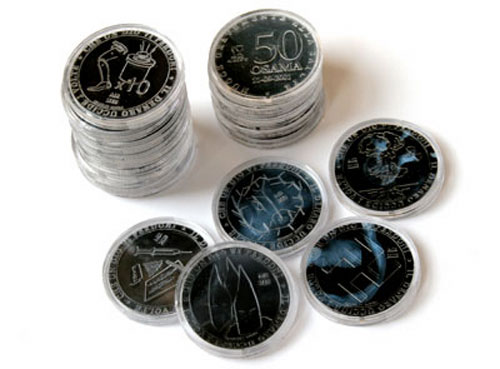 ‘transparent/ x-ray coins’ by an unknown artist
‘transparent/ x-ray coins’ by an unknown artist
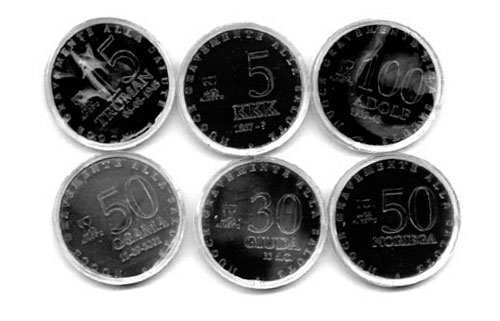 ‘transparent/ x-ray coins’ by an unknown artist
‘transparent/ x-ray coins’ by an unknown artist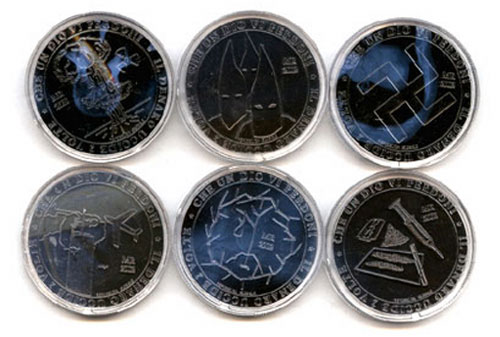 ‘transparent/ x-ray coins’ by an unknown artist
‘transparent/ x-ray coins’ by an unknown artist
transparent/ x-ray coins by an unknown artist each coin is made from clear plastic which seals an x-ray inside. the pieces feature the figure-heads and tyrants behind human atrocities, ‘evil’ organizations and world changing events in history: hitler, stalin, osama bin laden, judas, noreaga and ‘god’ are included.
the value of the coins is relative to the cost each person had on human life and the suffering they caused. for example hitler’s is valued at 100 with noreaga and bin laden worth 50, the klu klux klan is worth 5 and the lowest denomination 1 is god. the text reads: ‘money seriously damages your health’.
the other side of the coin shows a graphic representation of the persons legacy- for example bin laden’s coin depicts the twin towers with noreagas’ showing narcotics and firearms. along with this the text reads: ‘let a god forgive them’ and ‘money kills twice’.
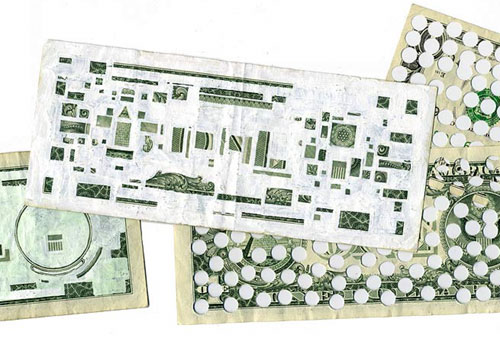 ‘my money, my currency’ by hanna von goeler
‘my money, my currency’ by hanna von goeler
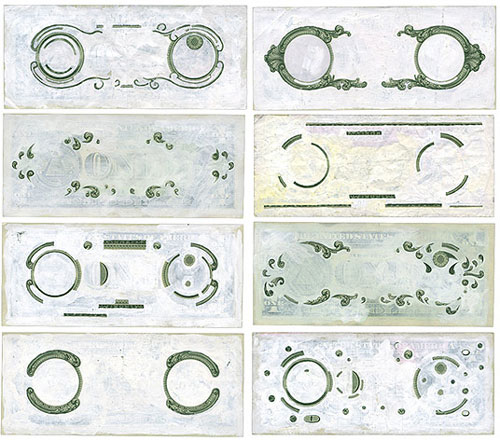 ‘my money, my currency’ by hanna von goeler
‘my money, my currency’ by hanna von goeler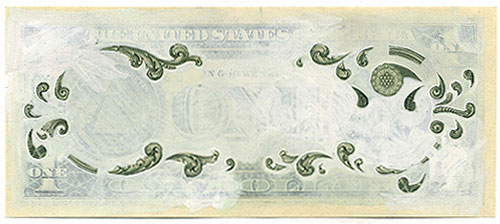 ‘my money, my currency’ by hanna von goeler
‘my money, my currency’ by hanna von goeler
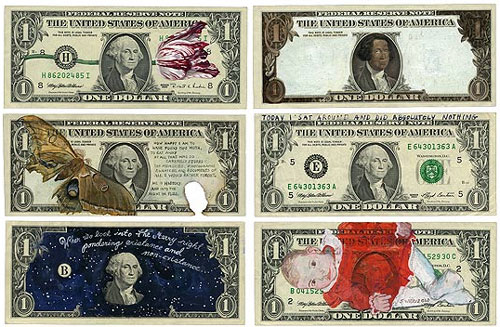 ‘my money, my currency’ by hanna von goeler
‘my money, my currency’ by hanna von goeler
‘my money, my currency’ by hanna von goeler the interstitial quality of money as it travels from person to person is the point of departure for hanna von goeler’s ‘my money, my currency’. in this this ongoing project the artist chronicles her struggle and relationship with money. exploring the ethical, political and aesthetic questions that surround notions of currency. the title of the project partially references warhol and walter benjamin with the phrase ‘my money’ but this body of work is not entirely about the reproduction of money. rather it is about the concept of currency what it is and who has it.
for the artist currency implies a general acceptance prevalence and trend. currency is about the exchange of something whether that be ideas, ethics, culture etc.
‘‘my currency is painting and drawing, my mind, ideas and spirit. money is what is there, currency is what I’ve added. drawing and painting money makes us notice its reproductive quality, as well as providing a textured way of various roles the object plays.’
‘painting on money also gives me some sense of power to determine – rather than be controlled by money’s function within society. this relates to the concept of agency; it explores the extent of to which we have the power to define rather than be defined by the currencies in our culture.’ HVG
to date hanna vongoeler has created more than five hundred one dollar artworks.
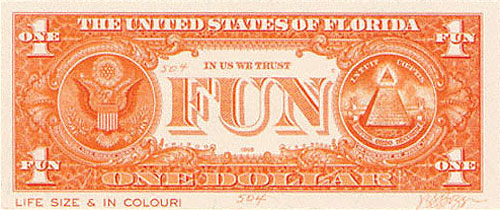 mad art by JSG boggs
mad art by JSG boggs
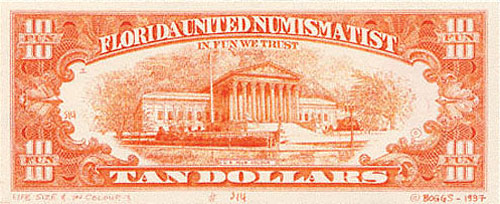 mad art by JSG boggs
mad art by JSG boggs
mad art by JSG boggs the american artist j.s.g. boggs refuses to sell his art, instead he buys things with it. since 1984 he has made ‘mad art’, which resembles currency. he doesn’t try to pass it off as actual bills, but instead tries to convince the seller of the piece’s intrinsic worth. due to the apparent similarities between official currency and bogg’s creations the US secret service often seizes his work. there have been several trials brought against him and he was repeatedly arrested for counterfeiting both in the US and abroad.
‘once I was an abstract painter, and I wanted to paint something real, so I started painting numbers. then I realized that numbers are not real they are total abstractions. money is also an abstraction; the transaction makes it real. for example using a boggs bill to buy a hamburger and receive in change, in other words what do you think it’s worth? and then the discussion ensues.’
‘my money looks completely different to ‘real’ money it is printed on one side and not on two. some are orange, some are red, some are green and some are yellow. they have my thumbprint on the back, they have my name on them – its unmistakably my work. no one would ever say that it was printed by the government or whoever, it’s a work of art about money‘ j.s.g. boggs
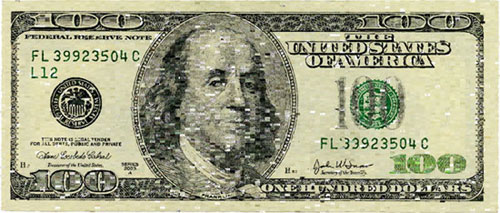 ‘ten thousand cents’ digital artwork by takashi kawashima and aaron koblin
‘ten thousand cents’ digital artwork by takashi kawashima and aaron koblin
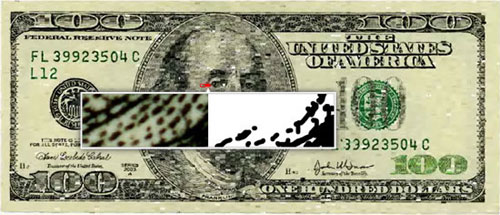 detail of the ‘ten thousand cents’ digital artwork
detail of the ‘ten thousand cents’ digital artwork
ten thousand cents digital artwork by takashi kawashima and aaron koblin ‘ten thousand cents‘ is a digital artwork that creates a representation of a 100 USD bill. the people behind the project, takashi kawashima and his partner aaron koblin, divided a 100 USD bank note into 10,000 sections. next they recruited participants using amazon’s ‘mechanical turk’, to reproduce one of the sections each, using a custom drawing tool, each participant was paid 1 cent. after five months of waiting, kawashima and koblin received all their digital reproductions.
the finished work is presented as a video piece with all 10,000 parts being drawn simultaneously. the project explores the circumstances we live in, a new and uncharted combination of digital labor markets, ‘crowdsourcing,’ ‘virtual economies,’ and digital reproduction.
exercise design your own currency
—

« BACK TO THE DESIGN-AEROBICS HOMEPAGE
DESIGN AEROBICS 2012 (22)
PRODUCT LIBRARY
a diverse digital database that acts as a valuable guide in gaining insight and information about a product directly from the manufacturer, and serves as a rich reference point in developing a project or scheme.

